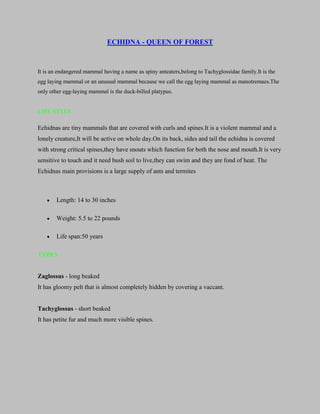Echidna
•Transferir como DOCX, PDF•
1 gostou•266 visualizações
Echidna, It is an endangered mammal having a name as spiny anteaters,belong to Tachyglossidae family.It is the egg laying mammal or an unusual mammal because we call the egg laying mammal as manotremaes.The only other egg-laying mammal is the duck-billed platypus.
Denunciar
Compartilhar
Denunciar
Compartilhar

Recomendados
Recomendados
Mais conteúdo relacionado
Destaque
Destaque (20)
Product Design Trends in 2024 | Teenage Engineerings

Product Design Trends in 2024 | Teenage Engineerings
How Race, Age and Gender Shape Attitudes Towards Mental Health

How Race, Age and Gender Shape Attitudes Towards Mental Health
AI Trends in Creative Operations 2024 by Artwork Flow.pdf

AI Trends in Creative Operations 2024 by Artwork Flow.pdf
Content Methodology: A Best Practices Report (Webinar)

Content Methodology: A Best Practices Report (Webinar)
How to Prepare For a Successful Job Search for 2024

How to Prepare For a Successful Job Search for 2024
Social Media Marketing Trends 2024 // The Global Indie Insights

Social Media Marketing Trends 2024 // The Global Indie Insights
Trends In Paid Search: Navigating The Digital Landscape In 2024

Trends In Paid Search: Navigating The Digital Landscape In 2024
5 Public speaking tips from TED - Visualized summary

5 Public speaking tips from TED - Visualized summary
Google's Just Not That Into You: Understanding Core Updates & Search Intent

Google's Just Not That Into You: Understanding Core Updates & Search Intent
The six step guide to practical project management

The six step guide to practical project management
Beginners Guide to TikTok for Search - Rachel Pearson - We are Tilt __ Bright...

Beginners Guide to TikTok for Search - Rachel Pearson - We are Tilt __ Bright...
Echidna
- 1. HYPERLINK quot; http://rareresources.blogspot.com/2010/08/echidna-queen-of-forest.htmlquot; ECHIDNA - QUEEN OF FOREST<br />It is an endangered mammal having a name as spiny anteaters,belong to Tachyglossidae family.It is the egg laying mammal or an unusual mammal because we call the egg laying mammal as manotremaes.The only other egg-laying mammal is the duck-billed platypus. LIFE STYLE <br />Echidnas are tiny mammals that are covered with curls and spines.It is a violent mammal and a lonely creature,It will be active on whole day.On its back, sides and tail the echidna is covered with strong critical spines,they have snouts which function for both the nose and mouth.It is very sensitive to touch and it need bush soil to live,they can swim and they are fond of heat. The Echidnas main provisions is a large supply of ants and termites <br />Length: 14 to 30 inches <br />Weight: 5.5 to 22 pounds<br />Life span:50 years<br />TYPES Zaglossus - long beaked It has gloomy pelt that is almost completely hidden by covering a vaccant. Tachyglossus - short beaked It has petite fur and much more visible spines. <br />HABITAT The Echidna has no fixed home except when the female is suckling its immature one. It will usually reside at scrubland and mosaic forest. Rare species.LOCATION <br />Australia<br />Tasmania<br />New Guinea<br />DEFENCE when it feels threatened <br />Scamber away by its short legs on a rigid shell such as a road and rocks.<br />Twist itself into a sphere, and only viewing sharp spines to its rival. <br />Burrows down below the shell of the soil and showing only its spines .<br />BREEDING<br />Gestation: 3 to 4 weeks<br />Number of young at birth: usually 1, rarely 2 or 3<br />Size at hatching: 0.47 inches (12 millimeters), 0.02 ounces (0.56 grams)<br />Age of maturity: unknown<br />The tend develops a pocket at the start of the mating season occurs in the month of July and August. After this matting, the female residence a den and lays egg into the pocket, usually it will take 10 days for an egg to originate. The young one attaches itself to a milk space inside the pocket and suckles for the next 8 to 12 weeks. Once spines developed for the young one,the female Echidna comes back regularly and let the young Echidna suckle.<br />
